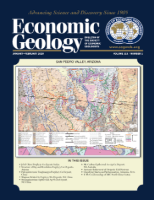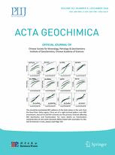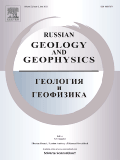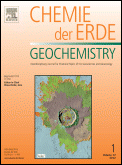
ECONOMIC GEOLOGY
Scope & Guideline
Advancing Knowledge in Geosciences Since 1905
Introduction
Aims and Scopes
- Porphyry and Epithermal Deposits:
A significant focus of the journal is on the geological, geochemical, and petrological aspects of porphyry and epithermal deposits. This includes studies on the processes that lead to the formation of these economically important mineral systems. - Mineral Chemistry and Geochronology:
The journal emphasizes the importance of mineral chemistry and geochronology in understanding the timing and mechanisms of mineralization. Research often involves isotopic studies and trace element analysis to elucidate the processes involved in ore formation. - Hydrothermal Processes:
Research on hydrothermal systems plays a crucial role in the journal, with a focus on fluid dynamics, mineral alteration, and the geochemical behavior of elements during hydrothermal events. - Environmental Geology and Sustainability:
The journal also addresses the environmental impacts of mineral exploration and mining, emphasizing sustainable practices and the geochemical behavior of contaminants in mining contexts. - Geospatial Techniques and Modeling:
Recent publications highlight the use of advanced geospatial techniques, including machine learning and remote sensing, to improve mineral exploration strategies and deposit characterization.
Trending and Emerging
- Advanced Geochemical Techniques:
Recent publications indicate a growing trend towards the use of advanced geochemical techniques, such as LA-ICP-MS and in situ isotopic analysis, to provide high-resolution data on mineralization processes. - Integration of Machine Learning in Exploration:
There is an emerging focus on the application of machine learning and artificial intelligence in mineral exploration, particularly in analyzing large datasets for identifying potential mineral deposits. - Sustainability and Environmental Impact Studies:
A notable increase in research addressing the sustainability of mining practices and the environmental impacts of mineral deposits reflects a shift towards responsible resource management. - Trace Element and Isotope Studies:
There is a rising interest in trace element and isotope studies, particularly concerning their role in understanding the genesis of mineral deposits and the conditions of their formation. - Interdisciplinary Approaches:
The journal is increasingly showcasing interdisciplinary research that combines geology with other fields such as environmental science, engineering, and economics to address complex challenges in mineral resource management.
Declining or Waning
- Traditional Geological Mapping:
There appears to be a declining emphasis on traditional geological mapping techniques as researchers increasingly adopt advanced technologies such as 3D modeling and remote sensing for mineral exploration. - Generalized Mineral Deposit Models:
The journal has seen a reduction in publications focused solely on generalized deposit models, as there is a shift towards more specific case studies that provide detailed insights into the unique processes of individual deposits. - Fundamental Geoscience Research:
There is a noticeable decrease in the number of papers dedicated to fundamental geoscience concepts without direct economic implications, as the journal increasingly prioritizes applied research that directly informs mineral exploration and extraction.
Similar Journals

Acta Geochimica
Advancing Geochemical Knowledge for a Deeper Understanding.Acta Geochimica is a prominent academic journal published by SPRINGER INT PUBL AG, focusing on the dynamic fields of Geochemistry and Petrology. Established in 2016, this peer-reviewed publication has quickly gained recognition within the scientific community, currently holding a category quartile ranking of Q3 in Geochemistry and Petrology as of 2023. With its ISSN 2096-0956 and E-ISSN 2365-7499, the journal offers a platform for researchers and professionals to disseminate and discuss significant advancements in the study of the chemical composition of the Earth and other celestial bodies. While it is not an open-access journal, Acta Geochimica plays a vital role in fostering collaboration and innovation among scientists, contributing to a deeper understanding of geochemical processes. Located in Switzerland at Gewerbestrasse 11, Cham CH-6330, Switzerland, this journal is a critical resource for students, researchers, and professionals seeking to push the boundaries of knowledge in Earth sciences.

Russian Geology and Geophysics
Exploring the Depths of Geology and GeophysicsRussian Geology and Geophysics is a seminal journal published by GEOSCIENCEWORLD that plays a pivotal role in the dissemination of vital research within the realms of Earth-Surface Processes, Geology, and Geophysics. With an ISSN of 1068-7971 and an E-ISSN of 1878-030X, this journal has witnessed a continuous evolution since its convergence in 2007 and is poised to thrive through 2024. While it is not an Open Access journal, it is recognized for its significant contributions to the academic community, holding a respectable Q2 ranking in Earth-Surface Processes and Q3 rankings in both Geology and Geophysics as of 2023. The journal’s impact factors align it within competitive quartiles, marking it as an essential resource for researchers and professionals seeking to stay at the forefront of geological and geophysical sciences. By publishing high-quality peer-reviewed articles, the journal fosters an environment of knowledge sharing and innovation, making it indispensable for students, practitioners, and scholars alike who are dedicated to advancing our understanding of Earth's complex systems.

Russian Journal of Pacific Geology
Advancing Knowledge in Earth SciencesThe Russian Journal of Pacific Geology is a pivotal resource in the realm of Earth sciences, published by PLEIADES PUBLISHING INC. With an ISSN of 1819-7140 and an E-ISSN of 1819-7159, this journal has established itself as a significant publication for researchers, professionals, and students who explore the intricate geology of the Pacific region. Covering a wide array of topics including Geochemistry, Petrology, Geology, Geophysics, Oceanography, Paleontology, and Stratigraphy, the journal's relevance is underscored by its categorization within Q3 quartile rankings across multiple disciplines in the 2023 metrics. Operating from the United States, its influential publications span from 2007 to 2024, attracting a diverse audience dedicated to advancing the geological sciences. Although not an open access journal, it serves as a valuable repository of knowledge, presenting original research, reviews, and critical discussions that enhance scholarly discourse. The journal is recognized within the global scientific community, addressing significant geological challenges while fostering collaboration and innovation among scholars in the Earth and Planetary Sciences.

Turkiye Jeoloji Bulteni-Geological Bulletin of Turkey
Bridging local insights with global geological challenges.Turkiye Jeoloji Bulteni-Geological Bulletin of Turkey (ISSN: 1016-9164) is a prominent scholarly journal published by the TMMOB JEOLOJI MUHENDISLERI ODASI in Türkiye, dedicated to advancing the field of geology through high-quality research and dissemination of significant scientific findings. With an emphasis on geological studies pertinent to the region and its global implications, the journal serves as a crucial platform for researchers, professionals, and students aiming to share and explore innovative theories, methodologies, and case studies. Although the journal operates under a traditional access model, its rich content provides valuable insights into varied topics including but not limited to mineralogy, geophysics, petrology, and environmental geology. Furthermore, the journal's commitment to exhibiting originality and relevance ensures its vital role in shaping geological research, fostering collaboration among academics and practitioners alike.

Journal of Geophysics and Engineering
Unveiling New Frontiers in Geophysics and EngineeringJournal of Geophysics and Engineering, published by Oxford University Press, stands as a pivotal platform for the dissemination of innovative research in the interdisciplinary fields of geology, geophysics, and engineering. Since its inception in 2004, this Open Access journal has focused on advancing the understanding of geophysical phenomena and their applications in engineering, receiving a commendable Q2 ranking in multiple categories for 2023, including Geology and Geophysics. With an impressive Scopus ranking reflecting its influence—such as a 143rd position in Earth and Planetary Sciences: Geology—this journal is essential for researchers, professionals, and students seeking to engage with cutting-edge advancements and policy discussions in these critical areas. The journal’s commitment to fostering knowledge and collaboration within the global scientific community positions it as a must-read for those dedicated to furthering geophysical and engineering sciences.

GEOLOGIA CROATICA
Fostering Collaboration in Planetary ScienceGEOLOGIA CROATICA is a distinguished open-access journal published by the Croatian Geological Survey, dedicated to advancing the field of Earth and planetary sciences. Since its inception in 1992, this peer-reviewed journal has become an essential resource for researchers, professionals, and students interested in various aspects of geology. With its robust impact factor and a prestigious place in Scopus rankings, ranking 127th out of 321 in Geology and 77th out of 159 in miscellaneous Earth and Planetary Sciences as of 2023, GEOLOGIA CROATICA maintains a strong international presence. It provides a platform for the dissemination of critical research findings, promoting collaboration and knowledge sharing among the global scientific community. By focusing on high-quality manuscripts that cover geological processes, hazards, and resources, this journal is pivotal for anyone looking to contribute to or expand their understanding of geological sciences. The journal's commitment to open access ensures that invaluable research is accessible to all, fostering a more informed and scientifically engaged society.

Geochemistry
Exploring the Earth's Chemical MysteriesGeochemistry is a distinguished academic journal published by Elsevier GmbH, focusing on the intricate study of geochemical processes across earth systems. With its ISSN 0009-2819 and E-ISSN 1611-5864, this journal serves as a crucial platform for scholars and researchers eager to disseminate their latest findings in geochemistry, petrology, and geophysics. The journal has established itself within the scientific community, achieving a Q2 ranking in both Geochemistry and Petrology as well as Geophysics, showcasing its significant impact and relevance—ranking 18th out of 165 in Geophysics and 26th out of 154 in Geochemistry and Petrology according to Scopus. From its inception in 1978 to its ongoing contributions through 2024, Geochemistry remains a vital resource for academic discourse and innovation in earth sciences. As an open-access title, it allows for broader dissemination of knowledge, promoting accessibility for researchers, students, and professionals. Whether you are engaged in theoretical research or applied studies, Geochemistry provides the insights necessary to advance our understanding of the planet's chemical complexity.

INTERNATIONAL GEOLOGY REVIEW
Unveiling the secrets of our planet, one article at a time.INTERNATIONAL GEOLOGY REVIEW, published by Taylor & Francis Inc, is a premier journal dedicated to advancing the field of geology since its inception in 1959. With its Q1 ranking in the field of Geology for 2023, this journal is a significant platform for researchers, professionals, and students exploring the intricacies of Earth and planetary sciences. The journal has been rated in the 81st percentile within Scopus rankings, reflecting its influence and the high quality of articles published. Although it does not offer Open Access options, the journal maintains a rigorous peer-review process to ensure the publication of original and impactful research. With an extensive archive projected to continue until 2024, INTERNATIONAL GEOLOGY REVIEW serves as an essential resource for those seeking to deepen their understanding of geological phenomena, making it a vital contributor to the global scientific community.

GEOLOGY OF ORE DEPOSITS
Navigating the Landscape of Ore DepositsGEOLOGY OF ORE DEPOSITS, published by PLEIADES PUBLISHING INC, stands as a pivotal resource in the fields of Economic Geology, Geochemistry, and Petrology. With an ISSN of 1075-7015 and an E-ISSN of 1555-6476, this esteemed journal caters to researchers and professionals by publishing rigorous studies on the formation, distribution, and exploration of mineral deposits. Although it operates under a subscription model, the journal offers insights that are vital for advancing knowledge in geological sciences. As represented in the Scopus rankings, it holds respectable positions within its categories—ranked Q3 in Economic Geology, Geochemistry and Petrology, and Geology for 2023, reflecting its significant contribution to the academic discourse. Covering a comprehensive timeframe from 1996 to 2024, it appeals not only to seasoned scholars but also to students seeking to deepen their understanding of ore deposit geology, thus fostering a rich learning environment and enhancing the field's scientific foundation.

Acta Geodynamica et Geomaterialia
Bridging Disciplines to Illuminate Earth's ComplexitiesActa Geodynamica et Geomaterialia is a well-regarded journal published by the Academy of Sciences of the Czech Republic, Institute of Rock Structure and Mechanics. Since its inception in 2004, this journal has established itself as a vital resource within the realms of Geology, Geophysics, and Geotechnical Engineering, categorized in the Q3 quartile across these fields as of 2023. With a focus on innovative research that addresses complex Earth dynamics and material behavior, it provides a platform for scholars and professionals to disseminate their findings and foster academic discourse. The journal holds an important position in the academic landscape, particularly for those engaged in interdisciplinary studies bridging geology and engineering. Although it is not an open access publication, its content remains pivotal for advancing knowledge and practices within these areas, making it an essential read for researchers and students alike. The journal's operational address is located in the vibrant city of Prague, Czech Republic, further enriching its academic character.